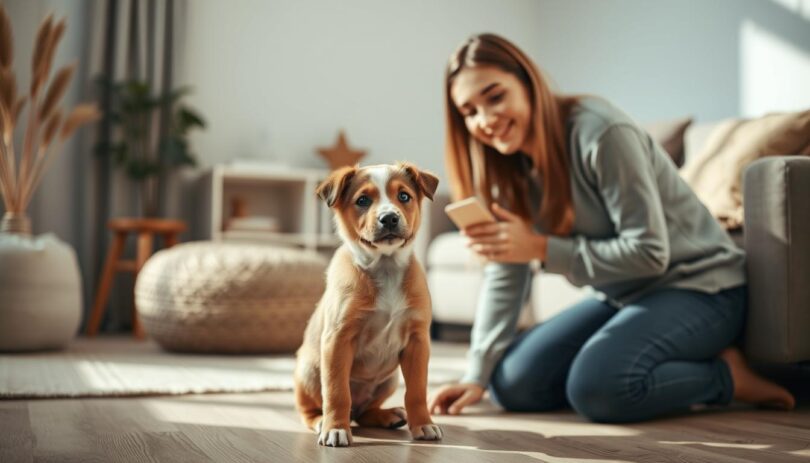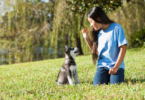Are you ready to unlock your puppy's full potential and build a lifelong bond with them? Bringing home a new puppy is an exciting journey, but it comes with responsibilities that shape their behavior and your relationship. Early training is key to raising a well-behaved dog and preventing future challenges.
This guide offers expert-backed advice, drawing from trusted sources like The Puppy Academy and top pet training blogs. We'll focus on positive reinforcement methods, essential commands, and daily routines to help you and your puppy thrive. Our goal is to empower you with practical insights while fostering a positive, supportive relationship with your pet.
By starting early, you'll lay the foundation for obedience, socialization, and a lifetime of good behavior. Let's dive into how you can create a strong, loving bond with your puppy through effective training.
Getting Started with Puppy Basics Training
Welcoming a new furry friend into your family is an exciting experience, but it requires careful preparation. Before bringing your new companion home, it's essential to create a safe environment. This includes puppy-proofing your space and setting up a dedicated area for learning. A stable and consistent setting helps your pet feel secure and focused.
Preparing for Your New Puppy
The first steps involve turning your home into a safe haven. Secure loose items, toxic substances, and electrical cords. Designate a quiet, distraction-free zone for training sessions. Having the right tools, like your pet's favorite toy, can make the process smoother and more enjoyable.
Setting Clear Training Goals
Establishing realistic goals from day one is crucial. Whether it's teaching the “sit” command or housebreaking, clear objectives guide the training process. Early integration of these lessons into daily routines reinforces good behavior and supports development. Consistency is key to building trust and confidence in your pet.
Expert advice emphasizes the importance of routines. By starting early and maintaining a consistent schedule, you lay the groundwork for a well-behaved and loving companion. This approach not only strengthens your bond but also ensures a positive start for your new friend.
Foundations of Basic Commands
Mastering essential commands like “sit,” “stay,” and “come” is the cornerstone of effective puppy training. These commands create a solid foundation for more advanced training and everyday interactions.
Teaching “Sit”, “Stay”, and “Come”
Starting with the “sit” command is often recommended. Hold a treat above your puppy's head and move it backward towards their tail. As they follow the treat with their nose, they'll naturally sit down. Reward them immediately with the treat and praise.
The “stay” command builds on “sit.” Have your puppy sit, then take a few steps back while saying “stay.” Gradually increase the distance and time you're away. Consistency is key to helping them understand this command.
The “come” command is vital for recall. In an open area, call your puppy by their name followed by “come” while running away. When they reach you, reward them with treats and affection. This positive reinforcement makes them eager to respond quickly.
Repetition and consistency are crucial. Even if progress seems slow, each session strengthens the foundation for future learning. Experts suggest starting these commands early to prevent behavior issues and ensure a smooth training experience as your puppy grows.
Housebreaking and Potty Training Techniques
Housebreaking is one of the most critical aspects of raising a well-behaved dog. It requires patience, consistency, and positive reinforcement to help your pup learn where it's appropriate to go. Establishing a routine and using effective reward systems are essential for successful potty training.
Establishing a Routine
A consistent schedule is key to housebreaking. Take your pup outside immediately after meals, naps, and playtime. Use a specific command like “go potty” to help them associate the action with the command. Young puppies need frequent trips outside, sometimes as often as every hour, until they develop better bladder control.
Effective Reward Systems
Reward your pup immediately with treats or praise when they go outside. This positive reinforcement helps them understand the desired behavior. Even small successes should be celebrated to build confidence and reinforce good habits.
Consistency is crucial. Watch for signs like sniffing or circling, which indicate your pup needs to go. If accidents happen, don't punish them—instead, clean the area thoroughly to remove any scent that might attract them again. With time and patience, your pup will learn to go outside reliably.
Crate Training for a Safe and Comfortable Home
Crate training is a powerful tool for creating a secure and comfortable environment for your pet. It not only helps with potty training but also reduces separation anxiety when approached positively. By introducing the crate gradually and making it a welcoming space, you can help your pet feel safe and relaxed.
Creating a Positive Crate Environment
Start by placing the crate in a quiet, visible area of your home where your pet can easily access it. Make sure the crate is comfortable by adding a soft bed or mat. To encourage your pet to enter the crate willingly, try placing a few treats or a favorite toy inside. This positive reinforcement helps build trust and curiosity.
Feeding meals inside the crate can also create a positive association. Begin by simply placing the food bowl near the crate, then gradually move it further inside as your pet becomes more comfortable. Praise your pet when they enter the crate calmly, reinforcing this good behavior.
A consistent schedule is key to successful crate training. Start with short periods, such as 10-15 minutes, and gradually increase the time as your pet becomes more comfortable. Always supervise your pet during crate time to ensure their safety and comfort.
Remember, crate training is not about confinement but about creating a secure space where your pet can relax. By introducing the crate in a positive and gradual manner, you can help your pet view it as a safe haven. This approach not only aids in potty training but also helps reduce destructive behaviors when you're not home.
Reward-Based Training Strategies
Reward-based training is a powerful approach to help your new puppy learn and grow. This method focuses on positive reinforcement, rewarding desired behaviors to encourage repetition. It's a key component in building trust and fostering a strong bond with your pet.
Selecting the Right Treats and Toys
Choosing the right treats and toys is essential for effective training. Opt for small, healthy treats that your puppy finds appealing. Variety keeps them engaged, preventing boredom and ensuring they stay motivated during sessions.
Timing is crucial. Rewards should be given immediately after the desired behavior to create a clear association. Using a clicker or a specific word can help mark the exact moment, enhancing learning and precision.
Different rewards serve different purposes. Treats are ideal for teaching new commands, while praise and affection work well for reinforcing good behavior in various situations. This variety supports diverse learning scenarios, keeping your puppy interested and eager to please.
Keep training sessions short and fun, around 10 minutes, to maintain your puppy's attention. End on a positive note to ensure a enjoyable experience for both of you. Consistent use of reward-based methods builds trust and improves behavior over time, creating a positive environment for learning.
Puppy Socialization: Meeting New People and Pups
Socialization is a cornerstone of your basic puppy's education, shaping their confidence and calmness in new situations. This critical process helps your pet navigate the world with ease, reducing the risk of anxiety or fear-based behaviors later in life.
Exposing Your Puppy to New Environments
Start by introducing your puppy to familiar family members before moving on to strangers. Gradual exposure to new environments, such as parks or busy streets, helps build confidence. Always monitor your puppy's reactions and adjust the process accordingly.
Positive social experiences are key. Consider controlled play sessions with other dogs or visits to pet-friendly locations. Reward calm behavior with treats or praise, reinforcing that good manners lead to positive interactions.
A patient approach to socialization helps your puppy get started on the path to becoming a well-mannered adult dog. By focusing on their comfort and confidence, you set the stage for a lifetime of positive interactions.
Practical Training Sessions and Daily Schedules
Creating an effective training routine is essential for your puppy's development. Short, focused sessions help maintain their attention and make learning enjoyable. Here’s how to structure your daily schedule for optimal results.
Keeping Sessions Short and Focused
Start with training sessions of 5-10 minutes, as puppies have shorter attention spans. This brevity ensures they stay engaged and absorb information better. As your puppy matures, you can gradually extend session lengths to 15 minutes. Always end on a positive note to keep them excited about learning.
Adapting to Distractions in Various Settings
Begin training in quiet areas to minimize distractions. As your puppy becomes more confident, introduce new environments like parks or busy streets. Use their name to get their attention and reinforce commands like “come” consistently. Over time, increase the distance and duration of commands to build reliability.
Balancing Routine and Flexibility
Structure your day with multiple short training sessions, playtime, and potty breaks. For example, take your puppy outside after meals and naps. Be flexible to adjust the schedule as needed, ensuring training remains enjoyable and stress-free. Consistency is key, but so is adaptability.
Bringing It All Together for a Happy, Well-Behaved Pup
Consistent, patient, and positive methods are the keys to successful development. By integrating techniques like basic commands, reward-based learning, crate training, and socialization, you create a strong foundation for your pet's growth.
View training as a continuous journey that builds a respectful relationship. Each training tip and structured day brings you closer to raising a confident, well-behaved companion.
Positive reinforcement, applied consistently, fosters good behavior and trust. Combine diverse techniques to keep learning engaging and effective.
For further guidance, explore resources, consult trainers, or subscribe to newsletters. Every effort contributes to a happy, well-behaved pup.
Feel empowered with expert guidance to support your pet's well-being through education and care.











Leave a Comment